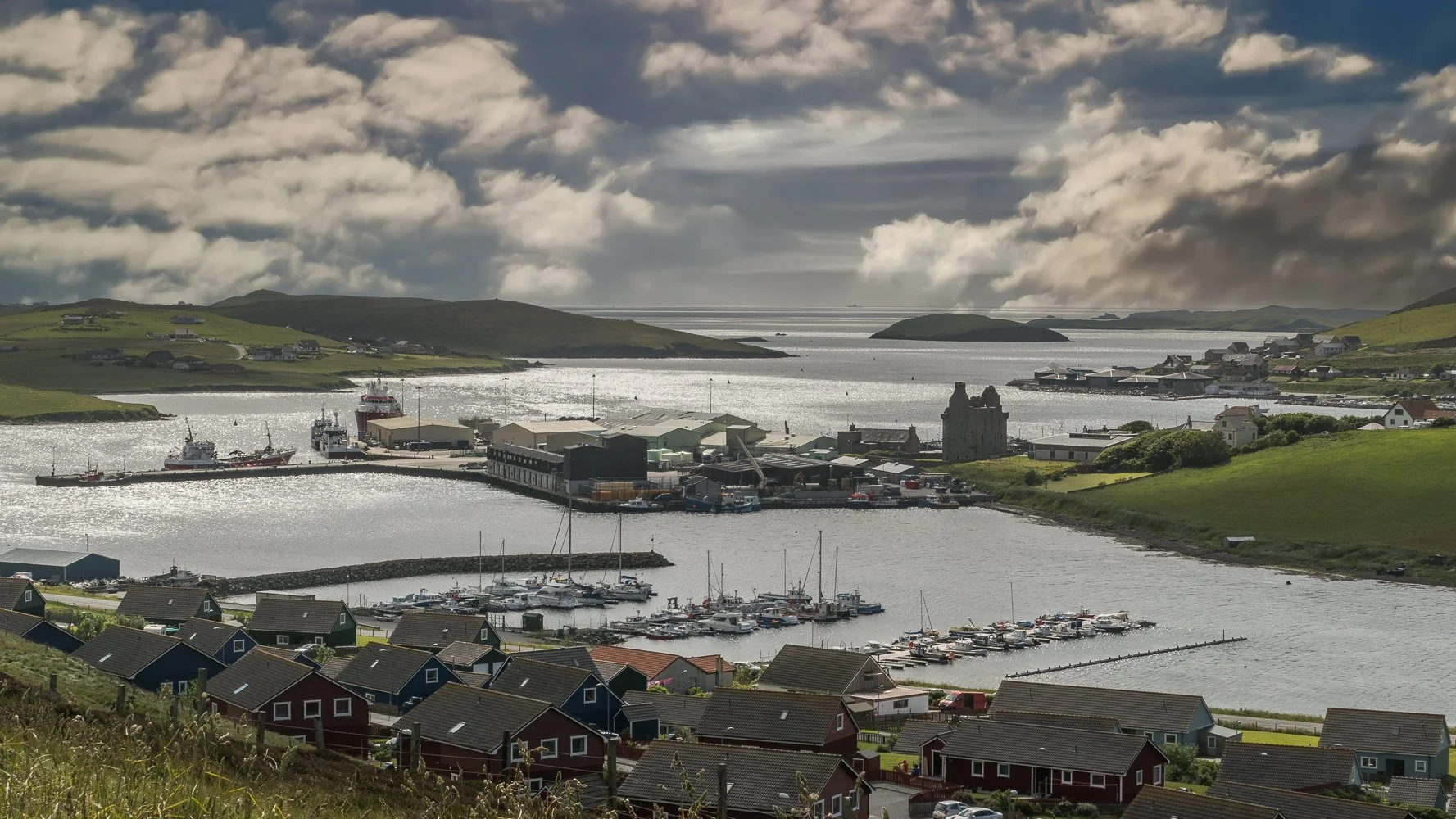What to Do!
“We had a day to explore the ‘mainland’ before catching an overnight ferry back to Aberdeen. It was going to be a busy day!”
Sea Kayaks Shetland offers guided Kayak trips!
When we first visited in the early 1970s, music was a big deal. It still is, I'm sure! Being budding musicians, we were keen to join in but somehow, we continued as consummers rather than creatives.
FARTY FIDLERS
‘Da Farty Fiddlers’ or ‘The Forty Fiddlers’ as it translates, was and still is a traditional group formed in 1960 faithfully upholding Shetland’s fiddling tradition. Shetland fiddle music wasn’t quite our cup of tea at the time but it was certainly part of the local pub scene when a couple of dudes in the corner whipped out their instruments to do their ‘Reel Thing’!
Then there was 'Peerie’ Willie Johnson, a legendary guitarist with a shock of white hair. Peerie (peerie meaning ‘small’ in Shetlandic) started playing the ukelele and later, when he progressed to the guitar, he took on the styles of Eddie Lang and Django Reinhardt. This was more interesting to us ‘Soothmoothers’ as we were keen players, though not nearly as good as Willie who did a good job of fusing elements of swing and jazz with traditional Shetland reels. Eventually, he got a regular gig with Shetland’s biggest dance band and the rest is local folk history.
COUNTRY WESTERN
But the most popular music by far on these islands at the time of our descent or ascent in the early 70s was ‘Country Western’.
Having spent my teenage years in the US, it bewildered me how Country Western could appeal so much, especially in rural communities throughout Scotland. It must have been the influence of ‘Westerns’ on the TV and cinemas. I remember friends of mine playing in pubs down in Ayrshire where clients would dress up in full cowboy duds and hold ‘drawing’ competitions.
Meanwhile, in Lerwick, we’d drink in bars like The Lounge, The Thule or the Legion to the strains of Loretta Lynn, Tammy Wynette, Conway Twitty and Buck Owens. For a bunch of Dundee hippies, it was all a bit bizarre but we got a kick out of that. Then there was the Marlex Pub which we also often got kicked out of!
Here’s another small island coincidence! The guy who drove me to and around the Isle of Whalsay for the Fishermen’s Mission Golf Invitational was Douglas, the son of Margaret and Alex (hence ‘The Marlex’), tea-total despite his trade who eventually took over his parent’s pub and renamed it ‘The Douglas Arms’. Small island!
SCALLOWAY
Ewan and I were on the move again to make the most of our day on ‘Mainland’.
There’s a viewpoint on the road from Lerwick to Scalloway looking over the attractive bay and town and across the Atlantic Ocean, next stop Iceland, Greenland and Labrador.
On the west side of the ‘mainland’, the village of Scalloway was the capital of these islands for a long time, a seafaring port where most of the scallops and whitefish are still landed.
On the other side of the harbour is the North Atlantic Fisheries College and ‘Da Haaf Restaurant’ which we tried to make for a late lunch. But we’d missed it!
Da Haaf Restaurant’s seafood chowder is one of the best I’ve ever tasted, simple but supremely satisfying.
Disappointed, we gave the ladies behind the counter a sob story about playing golf too late and lo and behold they produced a seafood chowder which was well worth the pleading. Dinner there is only served on Friday & Saturday evenings.
THE SHETLAND BUS
Scalloway Museum in the middle of town gives details of the so-called 'Shetland Bus', a World War II clandestine operation that maintained communication with the resistance movement in Nazi-occupied Norway. Scalloway was responsible for organising the ferrying of refugees and the shipment of secret agents or weapons from Shetland to Norway.
The sort of fishing boat that would regularly cross to Norway carrying papers, people, arms, equipment and expertise to sabotage and combat the German invaders.
The ruins of Scalloway Castle stands on a narrow promontory near the water. The infamous Earl Patrick Stewart was responsible for its construction in 1600 using forced local labour. His and his son's tyrannical behaviour was known throughout Shetland and Orkney until he was executed for his bad behaviour.
SCALLOWAY HOTEL
Scalloway Hotel is probably the best place for fine dining on these islands. The bar area is certainly popular for fish & chips but we were dining in style in the main restaurant.
SUMBURGH HEAD
At the southern tip of Shetland, Sumburgh is the site of the islands’ main airport with regular daily flights from Aberdeen. During the Oil Boom, this was a fairly busy spot.
Sumburgh Head Lighthouse, Visitor Centre and Nature Reserve is a series of attractions wrapped into one. The cliffs surrounding the lighthouse are teeming with birdlife during the summer breeding season and this is where you’ll get those great close-up shots of puffins. You might also catch a glimpse of dolphins, porpoises, Killer and Minke whales from this lofty vantage point.
Puffins pose only feet away.
JARLSHOF
Jarlshof is the primary prehistoric site in Shetland. Bronze Age settlers were the first to built small oval houses here with thick stone walls. The Iron Age people added a broch and a defensive wall. The Picts decorated the place with various works of art in a hippy-like manner and the Vikings no doubt bullied everyone around and added their graffiti and longhouses. Finally The Scots came and built a fortified manor house which is the main edifice you see today surrounded by more ancient stone piles.
ST NINIAN’S ISLE
During the summer, it’s easy to walk along the sandy spit or tombolo, the longest in the UK, to St Ninian’s Isle
St Ninian's Isle is a small rocky outcrop connected to the Shetland mainland by the largest tombolo in the UK. You can walk across the 500-metre-long sandy stretch during the summer months when it’s above sea level. During the winter, that’s maybe not such a good idea!
As the name suggests, the island has ecclesiastical connections, as do many in the Northern Isles, Hebrides and Faroes. However, its history is much older than Christianity. Neolithic graves were found within the walls of the 12th-century chapel ruin still seen near the end of the tombolo. Also found in the 1950s was an 8th-century hoard of silver, suspected to have been buried during a Viking raid.
SHETLAND MUSEUM
As our cultural day, as well as the trip, drew to an end there was one, final stop before we queued up for the ferry back to Aberdeen and mainland Scotland. It was the award-winning Shetland Museum and Archives officially opened in 2007 by HM Queen Sonja of Norway and the Duke & Duchess of Rothesay (aka. King Charles & Camilla). It’s a pretty impressive installation taking you back to when Shetland was part of Antarctica.
BACK SOOTH
It was time to head ‘sooth’ and we were first in the queue for the ferry. It wasn’t that we were desperate to get away! We’d simply had enough in a very good way. There’s so much to see and do on these islands, so many different experiences, such a quality of life that is rare to find these days, there comes a point when you realise you have to ‘come back down’ to earth again, the normal world.
On this visit, I went as far as fantasising about living here, that’s how much the place got to me. I’d go to Scalloway for all its fresh, delicious seafood, play my golf at the Dale and take frequent trips out to Whalsay. Or maybe rent a croft near Haroldswick on Unst. I’d then set about reclaiming the Unst Golf Course from the sheep. Then it would once again be the most northerly golf course in Britain.
TRAVEL FACTS
Northlink is the best way to get to Shetland, a superb service all the way so it’s like your holiday begins as soon as you get on board in Aberdeen the night before. For more information visit www.northlinkferries.co.uk or telephone +44 (0)1856 885500








